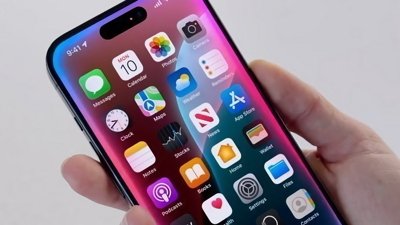The origins of iDVD
Apple introduced its iDVD authoring software in 2001, originally shipping it only with SuperDrive-equipped Macs as a way to sell users on new DVD burning hardware. While data and files could be burned to DVD as easily as standard CDs, mastering DVD movies that could playback on a standard DVD player required special software for titling and chapter definition as well as transcoding the video into the MPEG-2 format.
Apple didn't want to waste any time entering the new market for DVD authoring, which it saw as a key element in its software-centric, digital hub strategy for differentiating its Mac platform from generic PCs in the late 90s, so it acquired Germany's Astarte, the maker of DVDirector and the original developer of the CD burning app Toast.
While Apple was reworking the firm's DVDirector to become the original DVD Studio Pro, it also wanted a simple consumer version. Astarte had a consumer version of its DVD mastering software in the works, but "it was terrible," reported Mike Evangelist, who joined Apple from Astarte.
In an interview printed by Pioneer Press, Evangelist and a group of Astarte developers described pitching the simplified app concept to Steve Jobs. "Jobs never glanced at their presentation," the article noted. "Instead, he walked up to a whiteboard and drew a square. This is the program, he said. Users will drag their movies here to create DVD menus. Then they'll click 'burn.' That's it. 'I don't want to hear anything about drawers or pop-out' windows, he said."
Jobs also had harsh criticism for the Astarte team building DVD Studio Pro, calling the original interface "brain-dead stupid." Apple ended up spending an additional six months on the product. It also released the simpler iDVD just in time for Macworld. Both products helped set the Mac platform apart at a crucial period of Apple's return to relevance.
DVD authoring was both computationally demanding, a factor that helped highlight the PowerPC processor's particular savvy at tasks like video transcoding, and also complex enough to greatly benefit from Apple's prowess at developing simple and easy to use software interfaces.
Part of the iLife digital hub
Shortly after introducing DVD Studio Pro, Apple bought Spruce Technologies and used its software to release DVD Studio Pro 2 in 2003 as an entirely new pro authoring app with a completely different interface. The same year, iDVD 3 was bundled along with iPhoto, iMovie and iTunes as part of the new iLife package. Previously, all of the individual apps had been free downloads.
Over the next three years, iLife expanded to include GarageBand and iWeb. In 2006, iDVD was opened up to enable burning to any DVD-R device rather than being exclusively tied only to Apple's built in SuperDrive models. From that point forward, iDVD was no longer helping to sell extra hardware by motivating users to upgrade to a SuperDrive.
Instead, all of the iLife apps were now being sold at retail, albeit at shareware prices, in order to add value to the Mac platform while generating enough revenue to sustain their development. That left Apple with less motivation to push DVD authoring, but another product from Apple would help deflate the company's interest in promoting iDVD to an even greater extent: online video sharing.
Gallery in the clouds
In 2007, Apple announced iLife 08 at a special event that demonstrated a new Dot Mac web application called Web Gallery built using the SproutCore JavaScript framework. The suite's various apps were tied into the cloud computing service to allow users to easily share and present their work online rather than burning it to disc. Jobs explained at the time that users could upload their vacation videos via iMovie at better than DVD quality and gave short shrift to the new version of iDVD that shipped in the box.
The next year, Dot Mac turned into MobileMe, and the fledgling Web Gallery became the harbinger for a new suite of web apps for handling email, contacts, calendar events, file transfers, and of course, a gallery of online photos and videos. Apple's aggressive software release schedule forced the new online suite into production to coincide with the release of the iPhone 3G.
That resulted in a weak introduction and lots of complaints from both Dot Mac users who experienced some transition issues as well as new users who found the apps overburdened to the point of being slow or even unreachable. Even so, Jobs' Apple wasn't about to retreat back into a media sharing strategy centered on disc burning.
Jobs the creator, destroyer
After all, this was the Jobs that had decisively killed the 3.5" floppy disc with the 1998 iMac after first introducing it in the 1984 Macintosh. After initially falling behind the curve with CD burning in the late 90s, Jobs' Apple had rushed to put CD burners on Macs but then largely obsolesced disc burning with the iPod just a few years later, using iTunes as a catalyst for the transition.
With the iPod, Jobs similarly pushed hard drive mechanisms into the limited capacity Flash-centric MP3 player market with the iPod Mini, only to then effectively kill off hard drive-based iPods with Flash models like the Nano, Touch, and iPhone, once flash RAM became cost effective enough to do so.
It should therefore not be too surprising that, after having jumped into DVD burning and become the leading prosumer authoring software vendor with DVD Studio Pro as well as a leader in consumer disc burning with iDVD, Jobs has now made it pretty clear that Apple sees the future of media sharing as happening through the cloud, not etched into plastic discs.
At this year's Macworld event, iDVD got no mention when marketing chief Phil Schiller took the wraps off iLife '09. Even the iLife banners at the event excluded any mention of the product (below). Since then, Apple has issued two press releases on iLife '09, and in both cases iDVD was relegated to one-off mentions as software capable of "creating DVDs." Similarly, references to the software on the company's iLife product page are anything but standout.
The iLife landing page prominently features iPhoto, iMovie, GarageBand, and iWeb while, information on iDVD is tucked away and accessible only via an inconspicuous link near the page's header. If those instances aren't enough evidence of Apple's lack of excitement for the software, bloggers pointed out Wednesday that the company fails to even mention iDVD on the retail packaging for iLife '09. Retail copies of iLife 08 referenced the software on both the front and back of the software jacket.
Thinking outside the disc
Apple's software-centric strategy draws attention to the new MobileMe Gallery and iWeb publishing features of iLife, which allow users to upload their video creations to the web for playback from desktop computers, mobile devices such as the iPhone and iPod touch, as well as Apple TV, the company's video distribution hobby.
Apple's conspicuous lack of promotion of iDVD also underscores the company's intentional snubbing of Blu-Ray, which the industry hoped would replace the DVD with an even more complex to author interactive menus, far greater transcoding demands, greater DRM security, and virtually unlimited storage.
Given Apple's healthy business in both HD and mobile movie rentals and MobileMe online publishing, contrasted with the disappointing pace of Blu-Ray adoption, it looks like the company has picked the right strategy.
 Prince McLean
Prince McLean




-xl-m.jpg)


-m.jpg)






 William Gallagher
William Gallagher
 Amber Neely
Amber Neely
 Andrew Orr
Andrew Orr



 Christine McKee
Christine McKee
 Chip Loder
Chip Loder








125 Comments
Perhaps they are waiting to come out with iDVD HD? Fresh with blue-ray compatible themes, apps and such? DVD Studio HD in Final Cut Suite 2 only? Who knows...
Snooze alarm folks... hit the button till our iMac/Mini/Pro refresh comes out.
Hung UP to dry?
I'm not looking for much from iDVD. But I want the program kept alive. I want to be able to create content that is viewable from some kind of removable permanent media. I don't always want to be connected via Web to look at content.
This is not the right strategy, at least it's not right to get rid of iDVD.
My boss is going to switch to Macs later this year. The tipping point? My taking his vacation videos and making a simple but cool-looking DVD from them (in one night). That's 3 Macs that will be bought because of iDVD.
I can't believe people want their wedding, vacation, performance, etc. videos only online, instead of on DVD (of course, I still buy CDs, so what do I know?).
I'll wait to get/install iLife '09 after the first round of patches, so I don't know if this has been fixed yet, but the previous version of iDVD was seriously broken if you wanted to create your own theme. I made a very simple no-frills 'Black' theme - black background, white letters, evenly-spaced buttons showing a still frame from the chapter - and every time I launch iDVD to make a new project or import something from iMovie it screws it up. The buttons get re-arranged, the font changes, navigation becomes random. I then have to manually correct everything and burn the disc before anything else happens. If I save the project in its final state and open it again later iDVD swaps in one of its own themes as if all the work I did never happened.
Please, Apple, if you're going to orphan the software, at least fix the themes so we can use it for basic video archival navigation. I don't care about moving clouds and baby toys. Keep it simple and reliable.